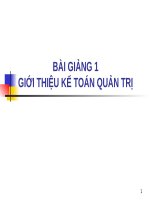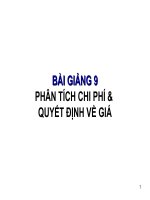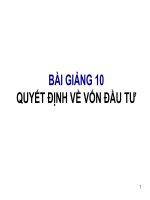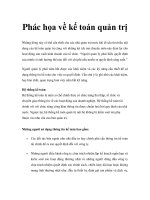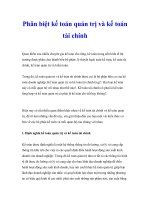ch14pr btap Financial Statement Analysis Ke toan quan tri
Bạn đang xem bản rút gọn của tài liệu. Xem và tải ngay bản đầy đủ của tài liệu tại đây (378.22 KB, 7 trang )
Problems: Set C
o l l e g e/ w
/c
www
.
Problems: Set C
1
g a n dt
wi
ey
ley.co m
Follow the rounding procedures used in the chapter.
P14-1C Comparative statement data for Litvin Company and Wisner Company, two
competitors, appear below. All balance sheet data are as of December 31, 2012, and
December 31, 2011.
Litvin Company
2012
Net sales
Cost of goods sold
Operating expenses
Interest expense
Income tax expense
Current assets
Plant assets (net)
Current liabilities
Long-term liabilities
Common stock, $10 par
Retained earnings
$1,570,000
1,080,490
302,275
6,800
62,500
325,975
521,310
66,325
108,500
500,000
172,460
Prepare vertical analysis and
comment on profitability.
(SO 4, 5)
Wisner Company
2011
2012
2011
$312,410
500,000
75,815
90,000
500,000
146,595
$340,000
238,000
79,000
1,252
7,650
83,336
139,728
35,348
29,620
120,000
38,096
$ 79,467
125,812
30,281
25,000
120,000
29,998
Instructions
(a) Prepare a vertical analysis of the 2012 income statement data for Litvin Company
and Wisner Company in columnar form.
(b)
Comment on the relative profitability of the companies by computing
the return on assets and the return on common stockholders’ equity ratios for both
companies.
P14-2C
The comparative statements of Dashwood Tool Company are presented below.
DASHWOOD TOOL COMPANY
Income Statement
For the Year Ended December 31
(SO 5)
2012
2011
$1,828,500
1,010,500
$1,750,500
996,000
Gross profit
Selling and administrative expense
818,000
516,000
754,500
479,000
Income from operations
Other expenses and losses
Interest expense
302,000
275,500
17,000
14,000
Income before income taxes
Income tax expense
285,000
85,000
261,500
77,000
$ 200,000
$ 184,500
Net sales
Cost of goods sold
Net income
DASHWOOD TOOL COMPANY
Balance Sheets
December 31
Assets
Current assets
Cash
Short-term investments
Accounts receivable (net)
Inventory
Total current assets
Plant assets (net)
Total assets
Compute ratios from balance
sheet and income statement.
2012
2011
$ 60,100
64,000
122,800
118,000
$ 64,200
50,000
102,800
115,500
364,900
332,500
605,300
520,300
$970,200
$852,800
2
chapter 14 Financial Statement Analysis: The Big Picture
Liabilities and Stockholders’ Equity
Current liabilities
Accounts payable
Income taxes payable
$160,000
43,500
$145,400
42,000
203,500
187,400
Total current liabilities
Bonds payable
Total liabilities
Stockholders’ equity
Common stock ($5 par)
Retained earnings
Total stockholders’ equity
Total liabilities and stockholders’ equity
210,000
200,000
413,500
387,400
280,000
276,700
300,000
165,400
556,700
465,400
$970,200
$852,800
All sales were on account. The allowance for doubtful accounts was $3,200 on December
31, 2012, and $3,000 on December 31, 2011.
Instructions
Compute the following ratios for 2012. (Weighted average common shares in 2012 were
62,500.)
(a)
(b)
(c)
(d)
(e)
Perform ratio analysis, and
evaluate financial position
and operating results.
Earnings per share.
Return on common stockholders’ equity.
Return on assets.
Current.
Acid-test.
(f)
(g)
(h)
(i)
(j)
Receivables turnover.
Inventory turnover.
Times interest earned.
Asset turnover.
Debt to total assets.
P14-3C Condensed balance sheet and income statement data for Testaverde Corporation
appear below.
TON CORPORATION
Balance Sheets
December 31
(SO 5)
Cash
Receivables (net)
Other current assets
Investments
Plant and equipment (net)
Current liabilities
Long-term debt
Common stock, $10 par
Retained earnings
2012
2011
2010
$ 25,000
50,000
90,000
75,000
400,000
$ 20,000
45,000
95,000
70,000
370,000
$ 18,000
48,000
64,000
45,000
358,000
$640,000
$600,000
$533,000
$ 65,000
80,000
350,000
145,000
$ 80,000
85,000
310,000
125,000
$ 70,000
50,000
300,000
113,000
$640,000
$600,000
$533,000
TON CORPORATION
Income Statement
For the Year Ended December 31
2012
2011
$740,000
40,000
$700,000
50,000
Net sales
Cost of goods sold
700,000
420,000
650,000
400,000
Gross profit
Operating expenses (including income taxes)
280,000
235,000
250,000
220,000
$ 45,000
$ 30,000
Sales
Less: Sales returns and allowances
Net income
Problems: Set C
3
Additional information:
1. The market price of Ton’s common stock was $4.00, $5.00, and $8.00 for 2010, 2011,
and 2012, respectively.
2. All dividends were paid in cash.
Instructions
(a) Compute the following ratios for 2011 and 2012.
(1) Profit margin.
(2) Asset turnover.
(3) Earnings per share. (Weighted average common shares in 2012 were 32,000 and
in 2011 were 31,000.)
(4) Price-earnings.
(5) Payout.
(6) Debt to total assets.
(b)
Based on the ratios calculated, discuss briefly the improvement or lack thereof
in financial position and operating results from 2011 to 2012 of Ton Corporation.
P14-4C
Financial information for Connor Company is presented below.
Compute ratios, and
comment on overall liquidity
and profitability.
CONNOR COMPANY
Balance Sheets
December 31
Assets
Cash
Short-term investments
Receivables (net)
Inventories
Prepaid expenses
Land
Building and equipment (net)
(SO 5)
2012
2011
$ 70,000
45,000
94,000
130,000
25,000
130,000
200,000
$ 65,000
40,000
90,000
125,000
20,000
130,000
175,000
$ 694,000
$645,000
$ 100,000
45,000
40,000
150,000
200,000
159,000
$100,000
42,000
40,000
150,000
200,000
113,000
$ 694,000
$645,000
Liabilities and Stockholders’ Equity
Notes payable
Accounts payable
Accrued liabilities
Bonds payable, due 2012
Common stock, $10 par
Retained earnings
CONNOR COMPANY
Income Statement
For the Years Ended December 31
2012
2011
Sales
Cost of goods sold
$840,000
615,000
$780,000
570,000
Gross profit
Operating expenses
225,000
190,000
210,000
180,000
$ 35,000
$ 30,000
Net income
Additional information:
1. Inventory at the beginning of 2011 was $120,000.
2. Receivables (net) at the beginning of 2011 were $88,000. The allowance for doubtful
accounts was $4,000 at the end of 2012, $3,800 at the end of 2011, and $3,700 at the
beginning of 2011.
3. Total assets at the beginning of 2011 were $615,000.
4. No common stock transactions occurred during 2011 or 2012.
5. All sales were on account.
4
chapter 14 Financial Statement Analysis: The Big Picture
Instructions
(a) Indicate, by using ratios, the change in liquidity and profitability of Connor Company
from 2011 to 2012. (Note: Not all profitability ratios can be computed.)
(b) Given below are three independent situations and a ratio that may be affected. For
each situation, compute the affected ratio (1) as of December 31, 2012, and (2) as of
December 31, 2013, after giving effect to the situation. Net income for 2013 was
$40,000. Total assets on December 31, 2013, were $700,000.
Situation
(1) 19,000 shares of common stock were sold
at par on July 1, 2013.
(2) All of the notes payable were paid in 2013.
The only change in liabilities was that the
notes payable were paid.
(3) Market price of common stock was $9
on December 31, 2012, and $12.60 on
December 31, 2013.
Compute selected ratios,
and compare liquidity,
profitability, and solvency
for two companies.
Ratio
Return on common stockholders’
equity
Debt to total assets
Price-earnings ratio
P14-5C Selected financial data of Target and Wal-Mart for 2008 are presented here
(in millions).
Target
Corporation
(SO 5)
Wal-Mart
Stores, Inc.
Income Statement Data for Year
Net sales
Cost of goods sold
Selling and administrative expenses
Interest expense
Other income (expense)
Income tax expense
$62,884
44,157
12,954
866
(1,371)
1,322
$374,526
286,515
70,288
1,863
3,779
6,908
Net income
$ 2,214
$ 12,731
Balance Sheet Data (End of Year)
Current assets
Noncurrent assets
$17,488
26,618
$ 47,585
115,929
Total assets
$44,106
$163,514
Current liabilities
Long-term debt
Total stockholders’ equity
$10,512
19,882
13,712
$ 58,454
40,452
64,608
Total liabilities and stockholders’ equity
$44,106
$163,514
Beginning-of-Year Balances
Total assets
Total stockholders’ equity
Current liabilities
Total liabilities
$44,560
15,307
11,782
29,253
$151,587
61,573
52,148
90,014
Other Data
Average net receivables
$ 8,069
$ 3,247
Average inventory
6,243
34,433
Net cash provided by operating activities
4,430
20,354
Instructions
(a) For each company, compute the following ratios.
(1) Current.
(7) Asset turnover.
(2) Receivables turnover.
(8) Return on assets.
(3) Average collection period.
(9) Return on common stockholders’ equity.
(4) Inventory turnover.
(10) Debt to total assets.
(5) Days in inventory.
(11) Times interest earned.
(6) Profit margin.
(b) Compare the liquidity, solvency, and profitability of the two companies.
Problems: Set C
P14-6C
The comparative statements of Haupt Company are presented below.
(SO 5)
HAUPT COMPANY
Income Statement
For Year Ended December 31
Net sales (all on account)
Expenses
Cost of goods sold
Selling and administrative
Interest expense
Income tax expense
Total expenses
Net income
2012
2011
$640,000
$510,000
410,000
150,000
7,500
18,000
585,500
$ 54,500
350,000
114,000
6,000
14,000
484,000
$ 26,000
HAUPT COMPANY
Balance Sheets
December 31
Assets
Current assets
Cash
Short-term investments
Accounts receivable (net)
Inventory
Total current assets
Plant assets (net)
Total assets
2012
2011
$ 41,000
18,000
90,000
86,000
$ 18,000
15,000
75,000
69,000
235,000
177,000
403,000
383,000
$638,000
$560,000
$122,000
23,000
$110,000
20,000
145,000
130,000
Liabilities and Stockholders’ Equity
Current liabilities
Accounts payable
Income taxes payable
Total current liabilities
Long-term liabilities
Bonds payable
Total liabilities
Stockholders’ equity
Common stock ($5 par)
Retained earnings
Total stockholders’ equity
Total liabilities and stockholders’ equity
110,000
80,000
255,000
210,000
150,000
233,000
150,000
200,000
383,000
350,000
$638,000
$560,000
Additional data:
The common stock recently sold at $19.50 per share.
The year-end balance in the allowance for doubtful accounts was $3,000 for 2012 and $2,400
for 2011.
Instructions
Compute the following ratios
(a) Current.
(b) Acid-test.
(c) Receivables turnover.
(d) Inventory turnover.
(e) Profit margin.
(f) Asset turnover.
(g) Return on assets.
Compute numerous ratios.
for 2012.
(h) Return on common stockholders’ equity.
(i) Earnings per share.
(j) Price-earnings.
(k) Payout.
(l) Debt to total assets.
(m) Times interest earned.
5
6
chapter 14 Financial Statement Analysis: The Big Picture
Compute missing information
given a set of ratios.
P14-7C Presented below is an incomplete income statement and incomplete comparative balance sheets of Eovino Corporation.
(SO 5)
EOVINO CORPORATION
Income Statement
For the Year Ended December 31, 2012
Sales
Cost of goods sold
$11,000,000
?
Gross profit
Operating expenses
?
2,665,000
Income from operations
Other expenses and losses
Interest expense
?
?
Income before income taxes
Income tax expense
?
580,000
Net income
$
?
EOVINO CORPORATION
Balance Sheets
December 31
Assets
Current assets
Cash
Accounts receivable (net)
Inventory
2012
2011
$ 440,000
?
?
$ 375,000
950,000
1,720,000
?
3,045,000
4,550,000
3,955,000
Total current assets
Plant assets (net)
Total assets
$
?
$7,000,000
$
?
?
$ 825,000
2,800,000
?
3,625,000
3,000,000
400,000
3,000,000
375,000
3,400,000
3,375,000
Liabilities and Stockholders’ Equity
Current liabilities
Long-term notes payable
Total liabilities
Common stock, $1 par
Retained earnings
Total stockholders’ equity
Total liabilities and stockholders’ equity
$
?
$7,000,000
Additional information:
1.
2.
3.
4.
5.
6.
The receivables turnover for 2012 is 10 times.
All sales are on account.
The profit margin for 2012 is 15%.
Return on assets is 24% for 2012.
The current ratio on December 31, 2012, is 2.5.
The inventory turnover for 2012 is 5.3 times.
Instructions
Compute the missing information given the ratios above. Show computations. (Note: Start
with one ratio and derive as much information as possible from it before trying another
ratio. List all missing amounts under the ratio used to find the information.)
Prepare income statement
with discontinued operations
and extraordinary loss.
(SO 6)
P14-8C Livesay Corporation owns a number of cruise ships and a chain of hotels. The
hotels, which have not been profitable, were discontinued on September 1, 2011. The
2011 operating results for the company were as follows.
Problems: Set C
Operating revenues
Operating expenses
$12,700,000
$ 8,700,000
Operating income
$ 4,000,000
Analysis discloses that these data include the operating results of the hotel chain,
which were: operating revenues $3,000,000 and operating expenses $4,000,000. The
hotels were sold at a gain of $100,000 before taxes. This gain is not included in the
operating results. During the year, Livesay suffered an extraordinary loss of $700,000
before taxes, which is not included in the operating results. In 2011, the company had
other revenues and gains of $200,000, which are not included in the operating results.
The corporation is in the 30% income tax bracket.
Instructions
Prepare a condensed income statement.
P14-9C The ledger of Leonard Corporation at December 31, 2011, contains the following summary data.
Net sales
Selling expenses
Other revenues and gains
$1,700,000
100,000
20,000
Cost of goods sold
Administrative expenses
Other expenses and losses
$1,000,000
100,000
30,000
Your analysis reveals the following additional information that is not included in the
above data.
1. The entire puzzles division was discontinued on August 31. The income from operations for this division before income taxes was $70,000. The puzzles division was
sold at a loss of $50,000 before income taxes.
2. On May 15, company property was expropriated for an interstate highway. The settlement resulted in an extraordinary gain of $80,000 before income taxes.
3. The income tax rate on all items is 30%.
Instructions
Prepare an income statement for the year ended December 31, 2011. Use the format
illustrated in the chapter’s Demonstration Problem (p. 651 in the textbook).
Prepare income statement
with nontypical items.
(SO 6)
7
